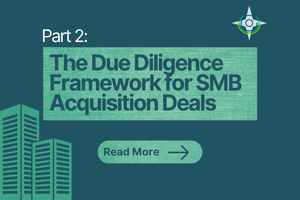 In Part 1, we introduced SMB acquisition investing as an emerging, cash-flow-driven, private asset class that offers a risk-return profile distinct from early-stage venture capital, making it a potentially attractive tool for portfolio diversification. Now, we turn to the practical process of evaluating these opportunities. (For a deep dive into this topic, we recommend registering for our upcoming webinar: "The Emerging SMB Asset Class.")
In Part 1, we introduced SMB acquisition investing as an emerging, cash-flow-driven, private asset class that offers a risk-return profile distinct from early-stage venture capital, making it a potentially attractive tool for portfolio diversification. Now, we turn to the practical process of evaluating these opportunities. (For a deep dive into this topic, we recommend registering for our upcoming webinar: "The Emerging SMB Asset Class.")
Investing in an acquired SMB requires a shift from vetting an idea's disruptive potential to scrutinizing a company's financial stability and operational durability. The following framework outlines the core areas of due diligence (DD) critical for evaluating an SMB acquisition opportunity.
1. Financial Diligence: Normalized EBITDA
The foundational metric for any SMB acquisition is Normalized EBITDA (Earnings Before Interest, Taxes, Depreciation, and Amortization). This is the baseline measure of the business's true cash-generating ability.
The key to financial DD is distinguishing between Reported and Normalized earnings.
- Add-Backs: Investors must analyze a company's books for discretionary or non-recurring expenses that will disappear under new ownership. Common "add-backs" include:
- Above-market owner salary or personal expenses run through the business (e.g., family travel, personal vehicle leases).
- One-time legal or professional fees.
- The Goal: Arriving at a clean, consistent EBITDA figure that represents what the business will earn under its new operator. This figure is used to calculate the valuation (e.g., $1.5M Normalized EBITDA × 4.5x Multiple).
2. Commercial Diligence: Stability and Moat
This area assesses the quality of the revenue and the defensibility of the business model. Unlike a tech company where the moat is (likely) proprietary software, an SMB's moat is often its entrenchment.
- Customer Concentration: This is a major red flag. A business is highly risky if a single customer accounts for more than 10-15% of total revenue. The ideal SMB has a broad, fragmented customer base, ensuring the loss of any one client is not catastrophic.
- Recurring Revenue: Is the revenue from repeat, contracted work (e.g., maintenance contracts, subscriptions, recurring reorders) or one-time jobs? High-quality SMBs have a significant portion of their revenue under a reliable, recurring structure.
- Competition and Geographic Lock-in: The business should operate in a market where barriers to entry exist—like specialized licenses, high equipment costs, or simply long-standing local brand reputation.
3. Management Diligence: Vetting the Operator
In the SMB acquisition model, investors are backing the operator (the "searcher") just as much as the business itself. The operator's role is not to invent, but to execute and professionalize.
- Operating Thesis: The operator must present a clear, realistic plan to generate value. This usually involves operational improvements (e.g., implementing better software, optimizing supply chains) rather than risky market expansion.
- Relevant Experience: Does the operator have the experience to manage a $5M to $15M revenue company? Their background should show a track record of P&L management, not just sales or engineering.
- Incentive Alignment: Investors should verify the operator's personal investment in the deal and the terms of their compensation. Strong alignment ensures the operator's financial success is tied directly to the performance and exit value of the acquired company.
By shifting their focus from speculative future growth to the tangible, historical durability of cash flow, private investors can effectively use the SMB acquisition market to introduce a stable, yield-focused dimension to their portfolio.
To learn more about this asset class, please register for our upcoming webinar.

